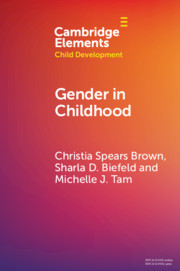Element contents
Gender in Childhood
Published online by Cambridge University Press: 13 October 2020
Summary
- Type
- Element
- Information
- Series: Elements in Child DevelopmentOnline ISBN: 9781108874281Publisher: Cambridge University PressPrint publication: 12 November 2020
References
- 22
- Cited by

